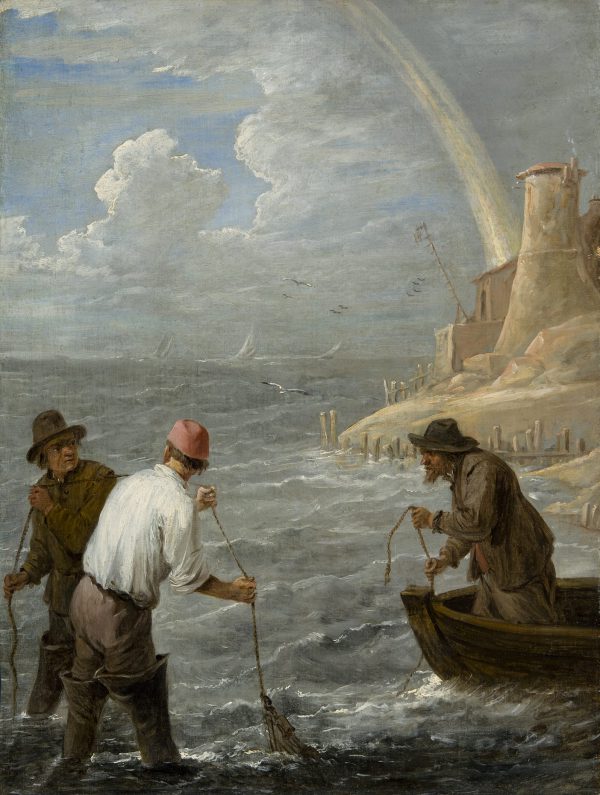Three Fishermen collecting their Fishing Nets
Oil on canvas, H. 0.59 m; W. 0.45 m
Monogram on the boat: DT.
Provenance: With Colien, Paris
Comte de Vence Sale, Paris, Hôtel de Vence, February 10th, 1761, no. 55
Blondel de Gagny Sale, Paris, Hôtel de Gagny, December 10th 1776, no. 83
Palais Stroganoff, Leningrad, during the19th century
Its sale, Paris, Galerie Georges Petit, May 22th, 1924, no. 15
Dr. Mañuel R. Espirito Santo Silva.
- DESCAMPS, Jean-Baptiste, La vie des peintres flamands, allemands et hollandais, tome II, Paris, 1754, p. 159.
- RÉMY, Pierre, Catalogue des livres, tableaux, dessins, et estampes de feu M. le comte de Vence, Paris, Prault, 1760, n° 55.
- SMITH, John, A catalogue raisonné, Tome III, London, 1831, n° 82.
- SMITH, John, A catalogue raisonné, Tome IX (supplément), London, 1842, n° 59.
- KLINGE, Margret, David Teniers the Younger: paintings – drawings, Anvers, Snoeck-Ducaju, 1991, p. 166-167.
- KLINGE, Margret ; LÜDKE, Dietmar, David Teniers der Jüngere 1610-1690, Alltag und Vergnügen in Flandern, exhibition catalogue, Staatliche Kunsthalle Karlsruhe, Heidelberg, 2005, p. 37.
Taught by his father, David Teniers the Younger became known as a genre painter, though he also tried his hand at portraits, landscapes, and historical paintings. Admitted to the Guild of Saint Luke in 1632, he married the daughter of Jan Brueghel the Elder, who was studying under Rubens. This union introduced him into the close social circle of the famous Flemish artist, which had a long-lasting influence on his painting. In 1645, Teniers became the Dean of the corporation of Saint Luke in Antwerp, and in 1647 was named painter of the court and curator of the collections of archduke Léopold-Guillaume, governor of the Netherlands. The archduke made Teniers’ works known in courts across Europe: Philippe IV of Spain, William II, Prince of Orange, and Christina, Queen of Sweden, collected his works. He was particularly involved in founding the Academy of Antwerp, where he was named Director in 1663.
In the great Antwerp tradition that included Francken and Bruegel, Adriaen Brouwer and Sébastien Vrancx, David Teniers mostly painted scenes of daily life, a genre he never ceased to widen and innovate. Bourgeois interiors, small bars or smoke dens, village festivals and rural working days, were all settings in which he expressed his good-natured virtuosity. He paints his subjects with a light, confident touch, capable of rendering the texture of a given material in great detail, enhanced by the interplay of colours and subtle light.
On display at the Stroganoff Palace all throughout the 19th century, our painting was described in their catalogue in the following terms: “The sea, lifted by the wind, breaks at the end of a cove, protected by a barrier and a stone slope on the right-hand side. A fisherman, standing in a boat of which we only see the bow, holds the rope of a fishing net, held up on the opposite side by two other fishermen. They have entered the water, in high boots; one, seen from behind, wears a red hat. Sailboats circumnavigate in the distance and a rainbow disappears behind a tower with a pink-tiled roof in a harmonious curve.”
This work is an example of one of Teniers’ lesser-known palates, characteristic of the 1640s and 1650s, during which the artist preferred to use silvery and lighter tones. In The Life of Flemish, German and Dutch Painters published in 1754, the art historian Jean-Gabriel Decamps underlined his finesse:
He completed several [paintings] where everything is light, with surprising effects. The Count of Vence, in his firm in Paris, has a painting of this kind; a fishing scene where we see a clear sky, and the water of the Sea, and the main figure is a man in a shirt, etc. Teniers thus proves that it is not always through the use of different colours that this harmony can be created; that it is often the blending itself to which we owe the effect of the diffusion of the vapour, and the masked distinctions between the different planes of the composition.
